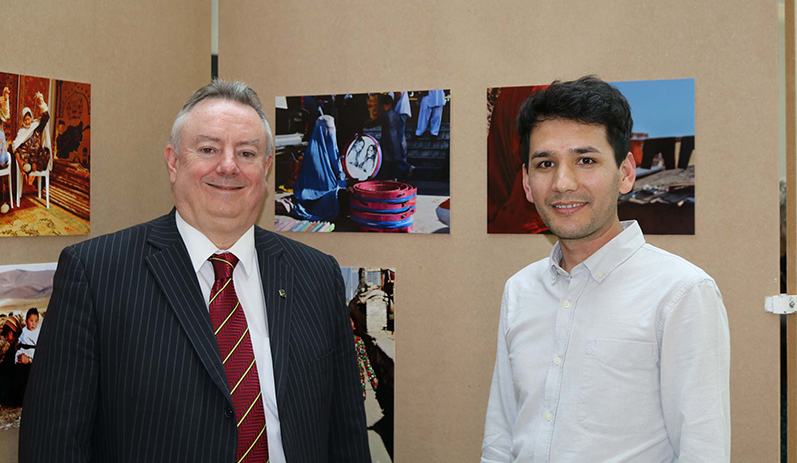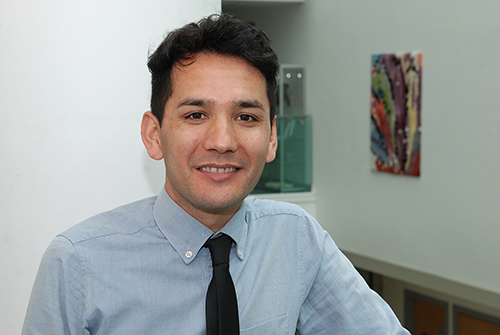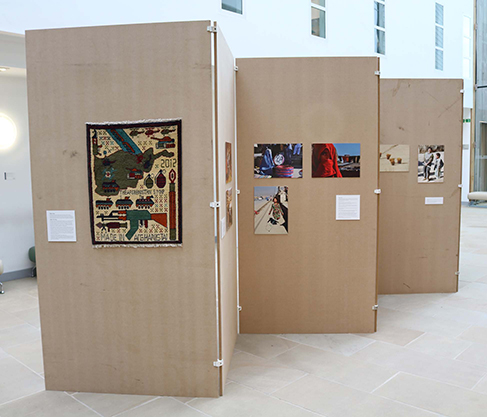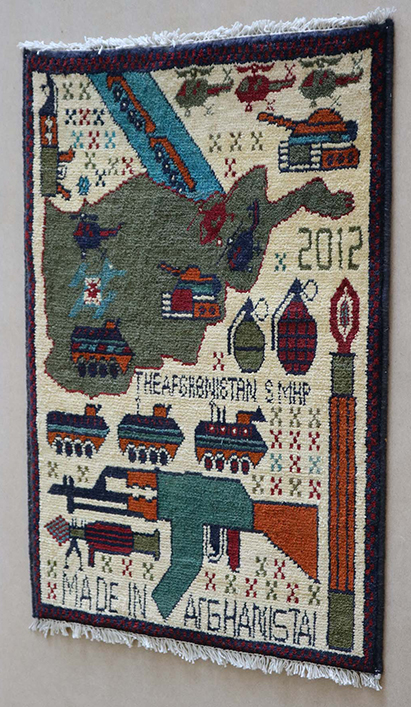The artist who changed the way the West views Afghanistan
 Dilara is pictured with the University Vice-Chancellor, Professor Bob Cryan, who has worked as a mentor to the Afghan artist
Dilara is pictured with the University Vice-Chancellor, Professor Bob Cryan, who has worked as a mentor to the Afghan artist
Thu, 02 Jun 2016 10:31:00 BST
“…from thinking of war and destruction they now think of culture and history because of what my exhibition has taught them…”
 AS a motivated young artist, he is keen to shed a positive light on the war torn, mediated image we are shown on a regular basis, to help us understand the life we do not see; the people, the art, the culture and the fascinating history of his homeland. “I want to capture peoples’ attention on this artwork for even a minute and show Afghanistan in a really positive way.”
AS a motivated young artist, he is keen to shed a positive light on the war torn, mediated image we are shown on a regular basis, to help us understand the life we do not see; the people, the art, the culture and the fascinating history of his homeland. “I want to capture peoples’ attention on this artwork for even a minute and show Afghanistan in a really positive way.”
Dilara (pictured left) is a research student of Afghan origin, currently studying for his masters in Contemporary Art. His exhibition, A glimpse of artwork from a conflict zone: Afghanistan’ portrays the work of artists from a country caught up in conflict. Dilara still has vivid memories of his childhood in Afghanistan, which inspire his research and artistic style, and influence the work he produces. He said: “My ideas are a bit dark compared to others, but it really connects with my personal experience and emotions and makes my work more effective and powerful.”
The exhibition is the first of its kind to be featured at the University, offering a new perspective on a country with such an unclear culture and heritage. It provides an amazing visual story of lives so different to our own cultural norms.
Though the Western world encourages freedom of speech and expression through art, fashion and culture, in Afghanistan and many other countries, harsh punishment can be the result of failing to adhere to strict social and religious codes of conduct.
 The exhibition showcased works from contemporary Afghan artists and photographers, who are based in Australia, USA as well in Kabul, Afghanistan. Dilara commented: “Surprisingly, three were female, which is really rare and unusual in terms of women’s rights in Afghanistan. Art is male dominated and women still have traditional roles there. When I was interviewing them they would tell me ‘You have to be strong here, if you [as a woman] stay at home nothing will change’.”
The exhibition showcased works from contemporary Afghan artists and photographers, who are based in Australia, USA as well in Kabul, Afghanistan. Dilara commented: “Surprisingly, three were female, which is really rare and unusual in terms of women’s rights in Afghanistan. Art is male dominated and women still have traditional roles there. When I was interviewing them they would tell me ‘You have to be strong here, if you [as a woman] stay at home nothing will change’.”
 Often Dilara would find the artists whose work he ended up exhibiting through social media and worked to build a relationship with them, which he still maintains. He keeps in touch with them through social media and helps them in any way he can to give their talents the chance to go beyond the troubled borders of Afghanistan.
Often Dilara would find the artists whose work he ended up exhibiting through social media and worked to build a relationship with them, which he still maintains. He keeps in touch with them through social media and helps them in any way he can to give their talents the chance to go beyond the troubled borders of Afghanistan.
As part of his project, Dilara asked visitors to take a short questionnaire before and after seeing the exhibition. Before the exhibition visitors were asked What comes to mind when you hear Afghanistan?– to which most repliedviolence, conflict and oppression and afterwards they were asked What do you think about Afghanistan now? – which received responses including ‘a country with rich complexity’ and ‘fascinating history’ suggesting the display had a positive impact.
“My exhibition was responsible for a big change in people’s views of Afghanistan,” said Dilara. “From thinking of war and destruction they now think of culture and history because of what my exhibition has taught them. I like to think of it as having given a cross cultural experience without the need to travel.”
Besides his own experiences, Dilara is influenced by contemporary artists Tracey Emin and Damien Hirst. Relating to Afghanistan, he began to discuss Steve McCurry’s iconic Afghan Girl, a piece of work with features similar to that on display in his exhibition. “You can see the war in her face, the pain in her eyes. You can see her suffering, but you can’t feel it. That image is so iconic that it sticks in your head because of the colour and the impact.”
One of the main attractions of the exhibition was an authentic Afghan war rug. Before the conflict, Afghan rugs would capture the image of the countryside, birds and trees. Eventually, there were no televisions or radios, and the people became so frustrated that they would record happenings of the war on the rugs, as though they were newspapers. They now show tanks and AK47s, rockets and hand grenades.
“The war rugs are really fascinating but there is a dark story behind them if you look closely. I created my own take on a war rug. I used the colours of the Afghan flag and I also brought poppies in. Poppies in this country are symbolic of people who have lost their lives fighting for their country and I included them to demonstrate how many people have lost their lives in Afghanistan.”
Looking to the future, Dilara hopes to return to university after his year working in the Huddersfield Students’ Union to study for his PhD and become a professional artist. His work on the art and culture of Afghanistan has opened a new exciting and unique path for other researchers and Dilara himself, from which he has set himself some impressive goals.
“Now that I have made a really good connection with artists in Afghanistan, I would like to make a documentary on the new wave of Afghan art, through meeting the artists face-to-face. I wish to continue with my practice and take my ideas to the next level and share my experience.”







